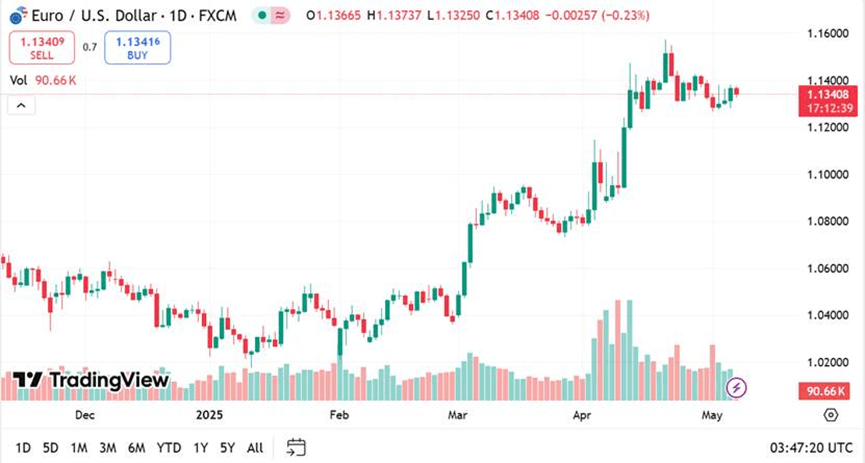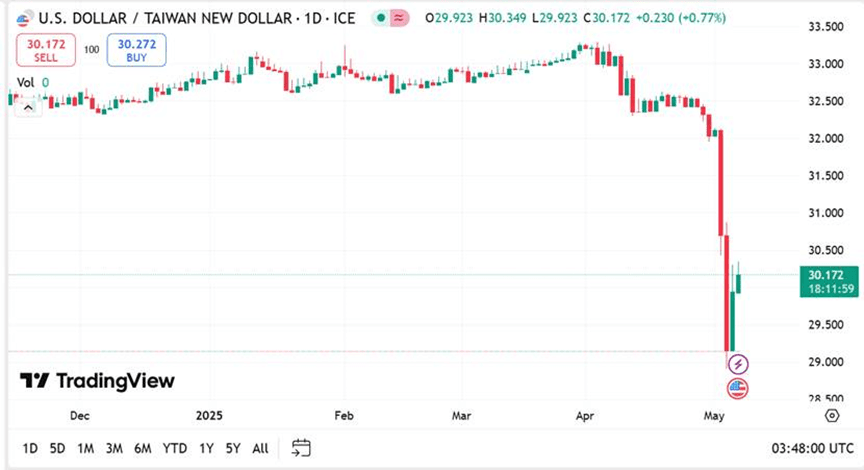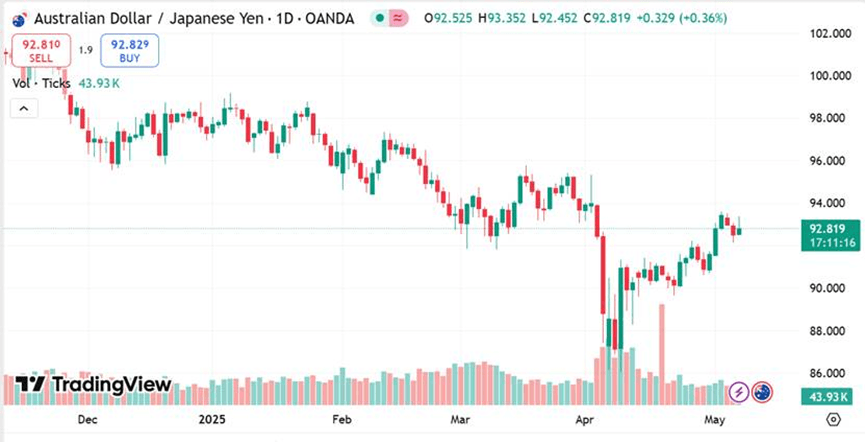
You are attempting to access a website operated by an entity not regulated in the EU. Products and services on this website do not comply with EU laws or ESMA investor-protection standards.
As an EU resident, you cannot proceed to the offshore website.
Please continue on the EU-regulated website to ensure full regulatory protection.
बुधवार मई 7 2025 10:30

5 मिनट

The foreign exchange market is experiencing notable movements among several key currency pairs, this analysis focuses on the fluctuations of the EUR/USD, the decline of the USD/TWD, and the rise of the AUD/JPY.
Forex market today: understanding these trends can provide insights into the current market dynamics and the factors influencing these currencies.
The EUR/USD currency pair has been characterized by volatility recently, reflecting a complex interplay of economic indicators and geopolitical developments. This pair is one of the most traded in the forex market, and its fluctuations can significantly impact global trading strategies.

source: tradingview
Economic Influences
Recent economic data from both the Eurozone and the United States has contributed to the fluctuations in the EUR/USD pair. Key indicators such as inflation rates, employment figures, and GDP growth are closely monitored by market participants. For instance, the European Central Bank's monetary policy decisions and the Federal Reserve's interest rate strategies play crucial roles in shaping the pair's trajectory.
Central Bank Policies
The policies of the European Central Bank (ECB) and the Federal Reserve are pivotal in determining the direction of the EUR/USD. Any signals regarding changes in interest rates or shifts in monetary policy can lead to immediate reactions in the forex market. Currently, the market is assessing the implications of recent statements from both central banks, which may influence future movements of the euro against the dollar.
Geopolitical Factors
Geopolitical events also impact the EUR/USD pair. Developments such as trade negotiations, political stability, and international relations can create uncertainty, leading to fluctuations in currency values. Traders are particularly attentive to how these factors may affect economic forecasts and market sentiment.
The USD/TWD pair has experienced a notable decline, primarily driven by the strength of the Taiwan Dollar. This movement reflects broader trends in the Asian currency markets and is influenced by several factors.

source: tradingview
Taiwan Dollar Surge
The recent surge in the Taiwan Dollar has been attributed to expectations surrounding trade agreements and economic growth prospects. As the Taiwan Dollar strengthens, it leads to a decrease in the value of the USD/TWD pair. Market participants are speculating on potential currency conversions by exporters in Taiwan, anticipating further appreciation of their domestic currency.
Trade Relations
The dynamics of trade relations between Taiwan and the United States are also crucial in understanding the USD/TWD movement. Recent discussions regarding trade agreements have sparked optimism, contributing to the Taiwan Dollar's strength. As negotiations progress, the market is closely watching for any developments that could further influence the currency pair.
Market Sentiment
Market sentiment plays a significant role in the USD/TWD fluctuations. The overall mood in the forex market, influenced by economic data and geopolitical events, can lead to rapid changes in currency valuations. The current environment is characterized by cautious optimism, which has favored the Taiwan Dollar against the U.S. Dollar.
In contrast to the USD/TWD, the AUD/JPY pair has seen an upward trend, reflecting a shift in market dynamics. This rise can be attributed to several factors, including economic performance and market sentiment.
source: tradingview
Economic Performance
The Australian Dollar has gained strength against the Japanese Yen, driven by positive economic indicators from Australia. Factors such as robust employment figures and strong commodity prices have bolstered the Australian economy, enhancing the appeal of the AUD. As a result, the AUD/JPY pair has benefited from this positive economic backdrop.
Risk Appetite
The rise of the AUD/JPY pair is also linked to changes in market risk appetite. The Australian Dollar is often viewed as a risk-sensitive currency, and its performance can be influenced by global economic conditions. As market sentiment improves, traders may favor the AUD over the Yen, leading to an increase in the AUD/JPY exchange rate.
Central Bank Divergence
The monetary policies of the Reserve Bank of Australia (RBA) and the Bank of Japan (BoJ) further contribute to the AUD/JPY movement. The RBA's stance on interest rates and economic growth contrasts with the BoJ's more accommodative approach. This divergence in monetary policy can create favorable conditions for the Australian Dollar, supporting its rise against the Japanese Yen.
The forex market is currently witnessing significant movements among key currency pairs, with the EUR/USD fluctuating, the USD/TWD declining, and the AUD/JPY rising. These trends are influenced by a combination of economic indicators, central bank policies, and geopolitical factors. As market participants navigate these dynamics, staying informed about the underlying influences will be essential for making strategic trading decisions.
Risk Warning and Disclaimer: This article represents only the author’s views and is for reference only. It does not constitute investment advice or financial guidance, nor does it represent the stance of the Markets.com platform. Trading Contracts for Difference (CFDs) involves high leverage and significant risks. Before making any trading decisions, we recommend consulting a professional financial advisor to assess your financial situation and risk tolerance. Any trading decisions based on this article are at your own risk.